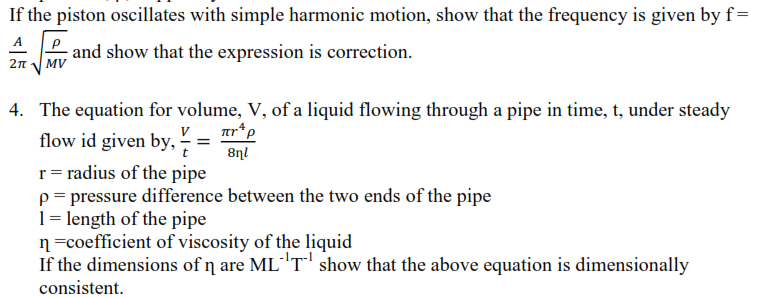
Physical quantities, units, and dimensions (A-level physics)


Physical quantities
Physical quantities are divided into two groups
(a) Fundamental quantities
These are physical quantities that cannot be expressed in the form of other quantities using any mathematical equations. They include
| Quantity | S.I unit | Symbol of S.I unit |
| Mass | kilogram | kg |
| Time | second | s |
| Length | metres | m |
| Temperature | Kelvin | K |
| Current | Ampere | A |
(b) Dimensional/derived quantities
These are physical quantities which can be expressed in terms of fundamental quantities. For example velocity, work, volume, density
Dimensions of physical quantities
This is a way in which derived quantities can be expressed in form of fundamental quantities. i.e.
Mass- M
Length- L
Time –T
The square bracket, [ ] is used to show dimensions
For example
(i) [Area] = length x length or length x width
L x L = L2
(ii) Volume = length x width x height
= L x L x L = L3


Application of dimensions
(i) To check the validity of equation (equations that are not dimensionally consistent are obviously wrong expression and should be discorded.
(ii) To derive equations: for correct equation, the units of the left hand side must be similar to the units of the right hand side.
All right equations must be dimensionally consistent but not all dimensionally consistent equations are correct.


Derivation of equation
The method of dimensions can be used to derive equations.
Examples 2
The period (T) of a pendulum bob depends on the length of the pendulum (L), mass of the pendulum ball, M, and acceleration due to gravity, g. Determine an expression for the period of a simple pendulum T in terms of the quantities mentioned.
Solution

Exercise
- The sphere of radius, α, moving through a liquid of density, ρ, and velocity, v, experiences a retarding force given by F = kαxρyvz, where K is a non dimensional constant. Use dimensions to find the values of x, y and z. [Ans, y =1, z =2 , y = 2]
2. Use dimensional analysis to show how the process of velocity transverse process vibration of a stretched string depends on its length, L, mass, m, and the tension F of the string V = KLxMyFz, where k is a non-dimensional constant. Find the values of x, y, z.
[Ans, x = ½ , y = – ½ , z = 1/2]
3. A cylindrical vessel of cross section area, A, contains air of volume, V, atmospheric pressure, ρ, trapped by frictionless down and released.

5.For streamline flow of a non-viscous incompressible fluid , the pressure, ρ, at a point is related to height, h. and velocity, V, by the equation
(p-a)=pg(h-b) + ½ p(v2 –d)
Where a, b, and d are constant and p is the density of fluid and g is the acceleration due to gravity. Given that the equation is dimensionally consistent. Find the dimensions of a, b, and d.

Sponsored by The Science Foundation College + 256 753 802709
Dr. Bbosa Science

I appreciate the effort you put into this. Garden & Outdoor
I’m always learning something new. Real Madrid News
The Top MBBS Colleges in Telangana are a top choice for aspiring medical students seeking excellence.
Get complete transparency with MBBS Fees Structure in Maharashtra.
Start playing with added advantages using the Raja Luck Invite Code.